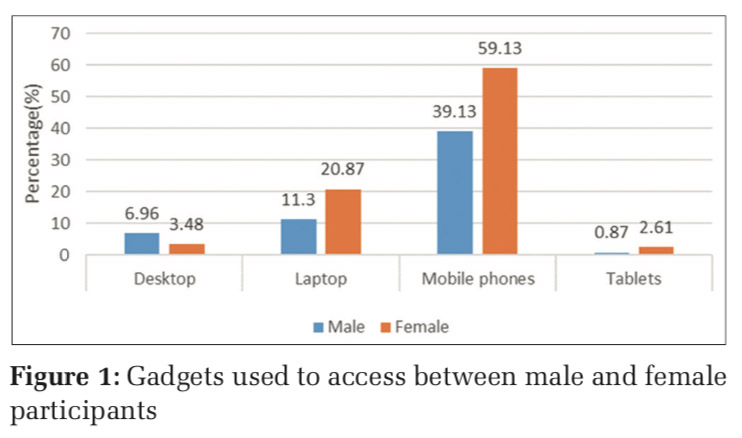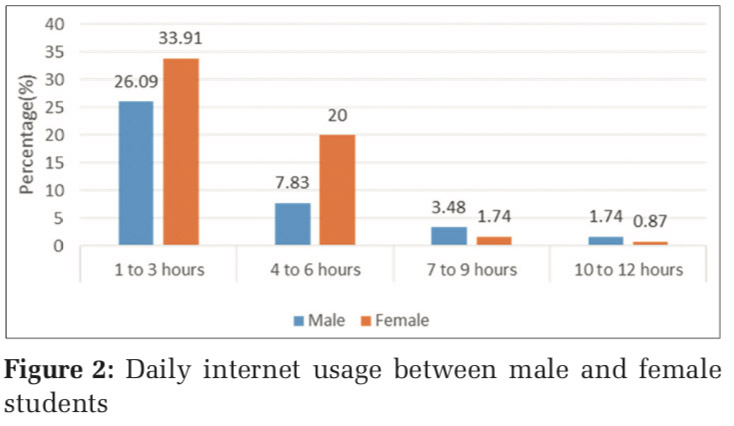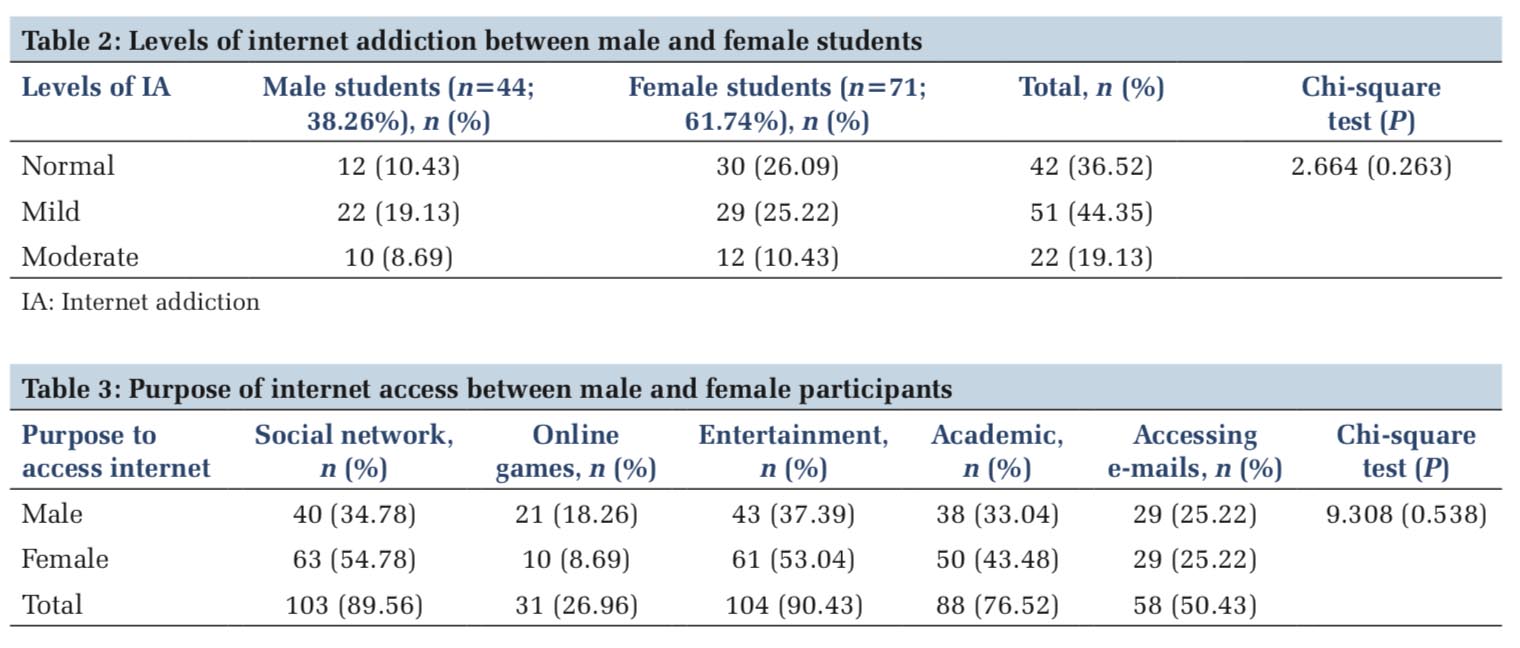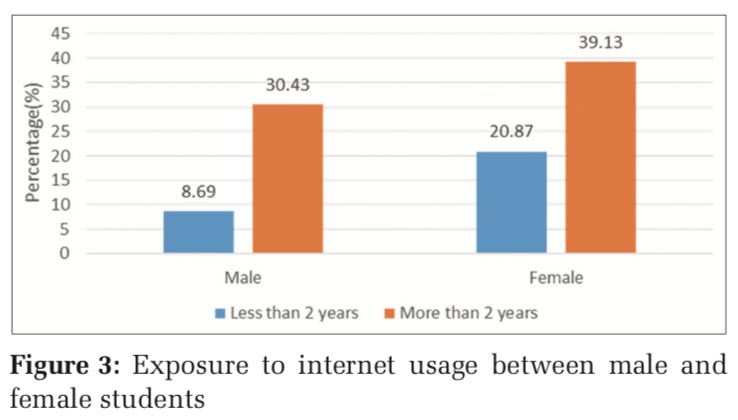

Journal of Medical Sciences and Health
DOI: 10.46347/jmsh.2019.v05i01.002
Year: 2019, Volume: 5, Issue: 1, Pages: 7-11
Original Article
T S Padmanabha1, H G Kshamaa2, S K Raghavendra3
1Department of Pharmacology, Adichunchanagiri Institute of Medical Sciences, Mandya, Karnataka, India,
2Department of Psychiatry, Kempegowda Institute of Medical Sciences, Bengaluru, Karnataka, India,
3Department of Community Medicine, Adichunchanagiri Institute of Medical Sciences, Mandya, Karnataka, India
Address for correspondence:
Dr. H G Kshamaa, Department of Psychiatry, 3rd Floor, B-Block, Kempegowda Institute of Medical Sciences, Hospital and Research Center, V. V. Puram, Bengaluru - 560 004, Karnataka, India. Phone: +91-7022728720. E-mail: [email protected]
ABSTRACTIntroduction: In the current competitive world, life without an internet is unimaginable. Internet can be utilized generously for overall progress toward accomplishing good aspects. However, it is misused or abused, especially among adolescent and young adults, due to their vulnerability for addiction. In this context, the study aims at finding internet addiction (IA) among students. Objectives: The objectives of this study were to explore and grade the severity of IA in relation to academic performance among medical undergraduates.Objectives: The objectives of this study were to explore and grade the severity of IA in relation to academic performance among medical undergraduates. Materials and Methods: This study was conducted on 146 2nd year medical undergraduates studying at Adichunchanagiri Institute of Medical Sciences, BG Nagara, after obtaining the Institutional Ethics Committee permission. Young’s IA test containing 20 questionnaires was introduced, along with this first theory internal assessment marks were obtained. Data were analyzed using the SPSS software and Chi-square test. Results: Of 146, 115 participated in the study with overall IA rate of 63.48% and the most common use being for entertainment purpose, followed by social networking and academics related activities. 27.82% of male students and 35.65% of the females were seen to be addicted to the internet. Among these students, 44.35% had mild addiction and 19.13% were moderately addicted to internet use. IA severity was not significantly associated with the students’ academic performance. Conclusions: Even though the students were mild to moderately addicted to internet usage, we were not able to find a direct relationship between internet overuse and their academic activities. Early care in such group can overcome the subsequent risk of progressing to severe addiction. KEY WORDS:Academics, internet addiction, medical students. |
Internet addiction (IA) has now become a voguish fever – depriving the impulsive excessive internet use makes an individual choleric and capricious behavior.[1] The term “Internet Addiction Disorder” (IAD) was first put forth by Ivan Goldberg, a New York psychiatrist in 1995.[2]
Profound prepossession to internet use, hardness to handle internet schedule, decline in social relationship, and appearing very annoyed if distracted when online are the common characteristic of such addiction.[3]
In addition to above features, IA can have various physical, social, and psychosocial challenges such as besotted profession, impaired academic fulfillment, headache, eye pain, and indigent eating habits. It can severely affect the health because, IA seems to have stronger association with mental illness such as anxiety, depression, and alcohol abuse.[4-6]
Internet utilization can be useful as well as misused to an extent that it becomes addiction and excess use can be pathological similar to gambling. This abusive nature of internet use has been used by various investigators by different jargon’s such as IA, internet dependence, pathological internet usage, or IA disorder (IAD).[7-9]
Many studies have been conducted across various countries to understand the prevalence of IA. A study conducted by Anand et al., on the prevalence of IA in engineering students revealed that about 27.1% of them suffered from IA.[10] A similar study conducted in Bangalore on students from various streams (science, arts, and computer science) revealed that the rate of IA was as high as 42%.[11] A meta- analysis study has shown that the prevalence of IA among medical students is comparatively 5 times higher than the general community and suggested that it may be secondary to increased academic stress, wherein students use the internet as a coping strategy.[12] Internet users in Asia are about 49.0% compared with rest of the world account to 51% in 2018.[13] Among Asians, India has the second highest percentage of internet users with 22.4%, while China has 38.9% user in 2018.[14] The prevalence of IAD is between 0.3% and 38% in different regions and Young reckoned that nearly 5%–10% of users are having IAD.[15,16]
A study in India has shown that the prevalence of 0.4% of medical students is internet addicts.[17]
The overall prevalence of IA across the world is 6%,[18] as compared to 0.7%[19]–18.88%[20] in India.
Since internet accessibility has become more easy with no strict limitations to online games, internet access duration, no parenteral control, and increased social network new friendships, it has made college students most vulnerable group for IA.[21]
Addiction to technology yields euphoric feel by activating reward centers. Further, it releases neurochemicals, of which dopamine and opiates are the major ones which keeps an individual high. Gradually tolerance develops over a period of time to the closely associated receptor requiring repeated stimulation to avoid abstinence response. Internet utilization can cause release of dopamine in one of the reward centers, i.e., nucleus accumbens, leading to dependence.[22]
Multiple studies have been conducted globally on adolescent’s internet use and IA. However, not many studies have explored the relationship between IA and academic performance. The present study was a sincere endeavor to deduce the internet use pattern as well as prevalence among them with an interest to providing supporting hands in such individuals.
Aim and objectives
The objectives of this study were as follows:
This cross-sectional observational study was carried out in Adichunchanagiri Institute of Medical Sciences, B G Nagara, Mandya, Karnataka. The study population comprised 146 2nd year medical undergraduates. The study was conducted during March–April 2016 after obtaining the Institutional Ethics Committee permission. The students were explained about the purpose and need of the study. Before collecting the data through self-administered questionnaire, students were assured of the data confidentiality and informed consent was obtained. 30 min period was given to fill the questionnaire.
Inclusion criteria
Exclusion criteria
Of the 146 students in the 2nd year MBBS, 31 students were not willing to participate in the study and hence were excluded.
Self-administered questionnaire contained the following four divisions:
Statistical analysis
Data were analyzed using MS Excel 2016. The analysis was done by descriptive and inferential statistics using Chi-square test analysis. P < 0.05 considered as statistically significant.
A total of 115 of 146 students participated in the study of whom 71 (61.74%) were male and 44 (38.26%) females with the age group between 19 and 22 years.
The overall prevalence of IA in the study population was 63.48% with moderate IA being 19.13% and mild IA being 44.35%. None of the students had any severe IA [Table 1].
The overall IA levels in male were 27.82% and female participants were 35.65% [Table 2].
The most common use of internet among students was for entertainment (90.43%) followed by social networking (89.56%) and academic use (76.52%); least purpose to access was online games (26.96%) [Table 3].
Commonly used gadgets to access internet were mobile phones (98.26%), followed by laptop (32.17%), desktop (10.43%), and tablets (3.48%) [Figure 1].
About 60% of the students daily use internet for a minimum period of 1–3 h [Figure 2].
About 69.57% of the students had an exposure to internet for more than 2 years and 29.57% for < 2 years’ period [Figure 3].
In our study, 63.48% of the students were addicted to internet, among whom 19.13%, mild IA being 44.35% [Tables 1 and 2]. This is in keeping with the recent studies conducted among medical students in India. Chaudhari et al.,[25] in 2016, which showed that 58.87% of the medical students had IA of whom 51.42% mildly addicted and 7.45% were moderately addicted to the internet. In another study, Sharma etal.[26] reported 42.7% prevalence of IA, 35% was mild, 7.4% moderate, and 0.3% severe addict professional college students in India.
On internet activities, percentage score shows that the students most commonly used internet for entertainment (90.43%) followed by social networking (89.56%) and academics (76.52%) [Table 3]. In a study conducted by Maroof et al.[27] assessing internet usage by medical students, it was found that the main use of the internet was for communication (58.5%) and entertainment, that is, downloading movies and games (46.3%). In another study by Chathoth et al.[20] on internet behavior pattern in undergraduate medical students in Mangalore showed most common purpose for internet use to be social networking (97.8%), findings of these studies are similar to our study findings. Contrarily, Kumar[28] found that 65.95% of the students use the internet for scanning the available literature, while 63.82% use it for the purposes of sending and receiving e-mail. 34.04% use it for online chatting with their friends.
Mobile was the most common gadget used (98.26%) by students to access internet in our study [Figure 1]. This is in keeping with the general trend of gadget use among all students as studied by Krishnamurthy etal.,[11] who found that 53% of students used mobiles for internet access.
About 60% of students in our study used internet for < 3 h and 27.83% from 4 to 6 h [Figure 2]. This is in accord with the study by Unnikrishnan et al.[29] which shows that 48.5% of the 1st and 2nd year medical students used internet for < 3 h.
We found no statistically significant association between the severity of IA and academic performance of the students [Table 1]. This is in contrast to the study conducted among medical students in Iran by Asiri et al.[30] which concluded that average scores of at risk and internet-dependent students were less than the healthy group. This is probably due to different demographics of the study population.





Although the IA is found to be more prevalent among students, it has been observed that it is mostly of mild-to-moderate severity and not directly affecting academic performance. Early intervention in this population may help curb the progress of addiction and should be a focus of attention.
Since the study is done on small sample size and on one particular phase of medical undergraduates and only pharmacology internal marks were considered, and hence, it is difficult to extrapolate the data. This study gives a scope for further exploration using larger sample size and inclusion of all phases of undergraduates with different geographic population might help in knowing the IA in a better way.
We thank the 2nd year medical undergraduates and pharmacology staff members for their kind cooperation.
Subscribe now for latest articles and news.